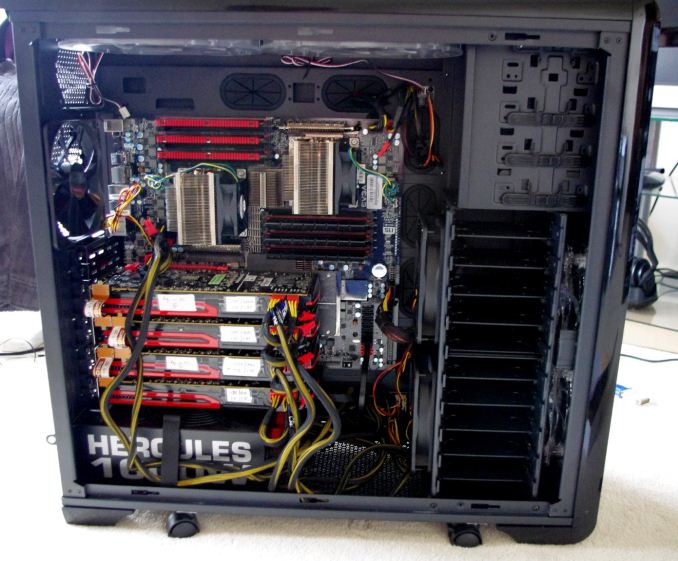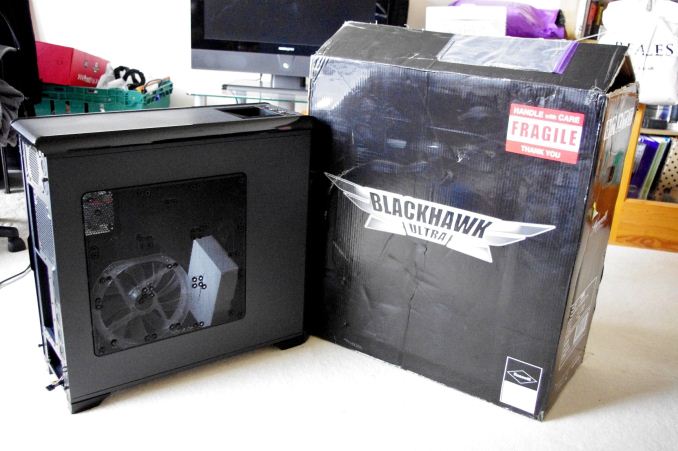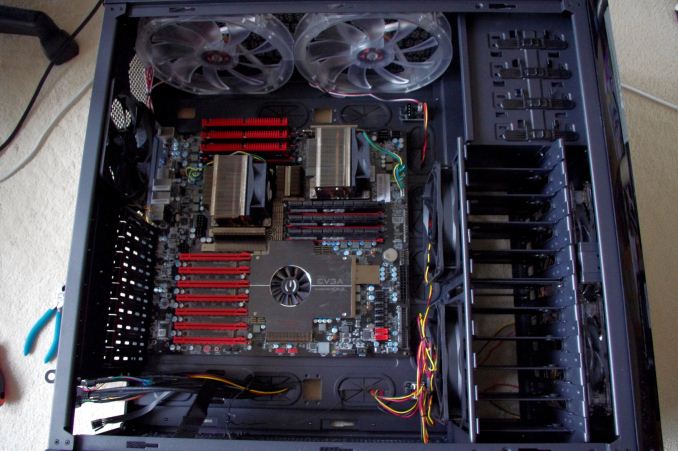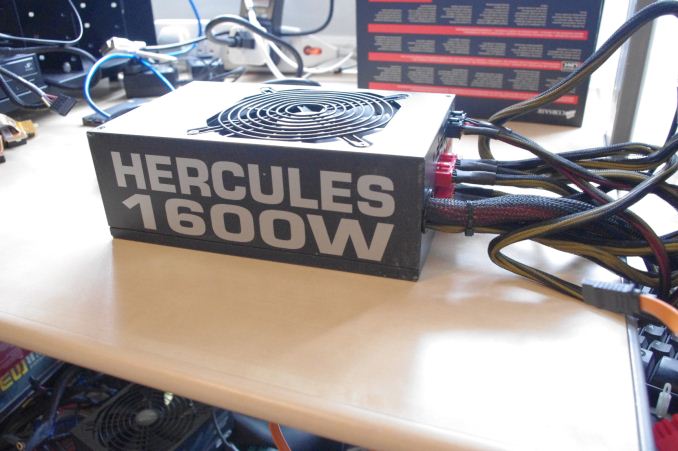Choosing a Gaming CPU: Single + Multi-GPU at 1440p, April 2013
by Ian Cutress on May 8, 2013 10:00 AM ESTTo start, we want to thank the many manufacturers who have donated kit for our test beds in order to make this review, along with many others, possible.
Thank you to OCZ for providing us with 1250W Gold Power Supplies.
Thank you to G.Skill for providing us with the memory kits.
Thank you to ASUS for providing us with the AMD GPUs and some IO Testing kit.
Thank you to ECS for providing us with the NVIDIA GPUs.
Thank you to Corsair for providing us with the Corsair H80i CLC.
Thank you to Rosewill for providing us with the 500W Platinum Power Supply for mITX testing, a BlackHawk Ultra, and 1600W Hercules PSU for extreme dual CPU + quad GPU testing, and RK-9100 keyboards.
Thank you to Gigabyte for providing us with the X5690 CPUs.
Also many thanks go to the manufacturers who over the years have provided review samples which contribute to this review.
Testing Methodology
In order to keep the testing fair, we set strict rules in place for each of these setups. For every new chipset, the SSD was formatted and a fresh installation of the OS was applied. The chipset drivers for the motherboard were installed, along with NVIDIA drivers then AMD drivers. The games were preinstalled on a second partition, but relinked to ensure they worked properly. The games were then tested as follows:
Metro 2033: Benchmark Mode, two runs of four scenes at 1440p, max settings. First run of four is discarded, average of second run is taken (minus outliers).
DiRT 3: Benchmark Mode, four runs of the first scene with 8 cars at 1440p, max settings. Average is taken.
Civilization V: One five minute run of the benchmark mode accessible at the command line, at 1440p and max settings. Results produced are total frames in sets of 60 seconds, average taken.
Sleeping Dogs: Using the Adrenaline benchmark software, four scenes at 1440p in Ultra settings. Average is taken.
If the platform was being used for the next CPU (e.g. Maximus V Formula, moving from FX-8150 to FX-8350), there's no need to reinstall. If the platform is changed for the next test, a full reinstall and setup takes place.
How to Read This Review
Due to the large number of different variables in our review, it is hard to accurately label each data point with all the information about that setup. It also stands to reason that just putting the CPU model is also a bad idea when the same CPU could be in two different motherboards with different GPU lane allocations. There is also the memory aspect to consider, as well as if a motherboard uses MCT at stock. Here is a set of labels correlating to configurations you will see in this review:
CPU[+][(CP)] (PCIe version – lane allocation to GPUs [PLX])
First is the name of the CPU, then an optional + identifier for MCT enabled motherboards. (CP) indicates we are dealing with a Bulldozer derived CPU and using the Core Parking updates. Inside the parentheses is the PCIe version of the lanes we are dealing with, along with the lane allocation to each GPU. The final flag is if a PLX chip is involved in lane allocation.
Thus, for example:
A10-5800K (2 – x16/x16): A10-5800K with two GPUs in PCIe 2.0 mode
A10-5800K (CP) (2 – x16/x16): A10-5800K using Core Parking updates with two GPUs in PCIe 2.0 mode
FX-8350K (2 – x16/x16/x8): FX-8350 with three GPUs in PCIe 2.0 mode
i7-3770K (3/2 – x8/x8 + x4): i7-3770K powering three GPUs in PCIe 3.0 but the third GPU is using the PCIe 2.0 x4 from the chipset
i7-3770K+ (3 – x16): i7-3770K (with MCT) powering one GPU in PCIe 3.0 mode
i7-3770K+ (3 – x8/x8/x8/x8 PLX): i7-3770K (with MCT) powering four GPUs in PCIe 3.0 via a PLX chip
Common Configuration Points
All the system setups below have the following consistent configurations points:
- A fresh install of Windows 7 Ultimate 64-bit
- Either an Intel Stock CPU Cooler, a Corsair H80i CLC or Thermalright TRUE Copper
- OCZ 1250W Gold ZX Series PSUs (Rosewill 1600W Hercules for The Beast)
- Up to 4x ASUS AMD HD 7970 GPUs, using Catalyst 13.1
- Up to 2x ECS NVIDIA GTX 580 GPUs, using GeForce WHQL 310.90
- SSD Boot Drives, either OCZ Vertex 3 128GB or Kingston HyperX 120GB
- LG GH22NS50 Optical Drives
- Open Test Beds, either a DimasTech V2.5 EasyHard or a CoolerMaster Test Lab
AMD Configurations
A6-3650 + Gigabyte A75-UD4H + 16GB DDR3-1866 8-10-10
A8-3850 + ASRock A75 Extreme6 + 16GB DDR3 1866 8-10-10
A8-5600K + Gigabyte F2A85-UP4 + 16GB DDR3-2133 9-10-10
A10-5800K + Gigabyte F2A85-UP4 + 16GB DDR3-2133 9-10-10
X2-555 BE + ASUS Crosshair V Formula + 16GB DDR3 1600 8-8-8
X4-960T + ASUS Crosshair V Formula + 16GB DDR3-1600 8-8-8
X6-1100T + ASUS Crosshair V Formula + 16GB DDR3-1600 8-8-8
FX-8150 + ASUS Crosshair V Formula + 16GB DDR3-2133 10-12-11
FX-8350 + ASUS Crosshair V Formula + 16GB DDR3-2133 9-11-10
FX-8150 + ASUS Crosshair V Formula + 16GB DDR3-2133 10-12-11 + CP
FX-8350 + ASUS Crosshair V Formula + 16GB DDR3-2133 9-11-10 + CP
Intel Configurations
E6400 + MSI i975X Platinum + 4GB DDR2-666 5-6-6
E6700 + ASUS P965 Commando + 4GB DDR2-666 4-5-5
Celeron G465 + ASUS Maximus V Formula + 16GB DDR3-2133 9-11-11
i5-2500K + ASUS Maximus V Formula + 16GB DDR3-2133 9-11-11
i7-2600K + ASUS Maximus V Formula + 16GB DDR3-2133 9-11-11
i3-3225 + ASUS Maximus V Formula + 16GB DDR3-2400 10-12-12
i7-3770K + Gigabyte Z77X-UP7 + 16GB DDR3-2133 9-11-11
i7-3770K + ASUS Maximus V Formula + 16GB DDR3-2400 9-11-11
i7-3770K + Gigabyte G1.Sniper M3 + 16GB DDR3-2400 9-11-11
i7-3930K + ASUS Rampage IV Extreme + 16GB DDR3-2133 10-12-12
i7-3960X + ASRock X79 Professional 16GB DDR3-2133 10-12-12
Xeon X5690 + EVGA SR-2 + 6GB DDR3 1333 6-7-7
2x Xeon X5690 + EVGA SR-2 + 9GB DDR3 1333 6-7-7
The Beast
The Beast is a special machine put together to help with the review as a result of various hardware coming into my possession all at the same time. The core of the system is an EVGA SR-2 motherboard, the best and last dual processor motherboard to deal with overclockable Xeon processors. This is paired with a couple of X5690 Xeon processors, the highest clocked Westmere Xeon that Intel offers, and many thanks to Gigabyte for loaning these to us for a pair of reviews. I went and purchased a pair of Intel Xeon socket 1567 coolers for the system, which have a 2U z-height restriction but are copper piped and cooled by powerful (and loud) delta fans. These provided enough cooling power to push the Xeons from 3.43GHz to 4.6GHz during some overclocking attempts, so are more than adequate for the job at hand (if you can put up with the noise).
Our system is paired with some high quality DDR3 Hyper memory, once famed for its overclocking prowess but due to frequent deaths from high voltage, is now relegated as a memory for overclockers. However at stock this memory performs great, often in the region of DDR3-2000 C7, so our memory kits are well primed for this setup.
Of course a full system is nothing without a case and power supply to help justify a build. With the motherboard being absolutely huge, no standard case would take it – only large cases designed for desktop-based server 2P motherboards are adequate. Luckily there is one case which is selling well, and Dustin reviewed recently – the Rosewill Blackhawk Ultra. Aside from the weight, this case had no issues with installing the motherboard; it could easily fit in another 10 HDDs, four optical bays, and any major GPU setup you could possibly think of – with plenty of fans just for good measure. Read Dustin’s review for a more thorough analysis, but I have some good shots of the system and motherboard installed for you:
Rosewill also has the perfect power supply for dealing with a dual processor, quad CrossFireX setup. First, consider how many connections this 2P setup needs – we have a normal 24-pin ATX connector for the motherboard, one 8-pin CPU power connector for each CPU, an additional 6-pin PCIe power connector for each CPU to provide extra power, another 6-pin PCIe power connector to provide power to the PCIe slots, and then two 6+2 PCIe power connectors for the GPUs. That makes 11 PCIe connectors needed in total, and this is alongside all the fans in the case and whatever SSD/ODD setup a user wants. The power supply used for this monster is the 1600W Hercules, rated 80PLUS Silver. With access to 16 PCIe connectors, the only way you might need any more is with a compute rig having seven single slot cards each needing two connectors. With the CPUs and GPUs both overclocked, our system was drawing almost 1500W at the wall (at a 240V source) under a high CPU+GPU load.
Using a 2P system as a desktop comes with its own set of issues, namely some CPU benchmarks not optimized for 2P, or in this case, some trouble getting some games to even work. It seems that the more money you can throw at a gaming system the more problems start to arise, but The Beast provides a nice comparison point when we look at high-end Ivy Bridge, Sandy Bridge-E and Piledriver processors in multiple-GPU setups.
Our first port of call with all our testing is CPU throughput analysis, using our regular motherboard review benchmarks.
































242 Comments
View All Comments
Spunjji - Wednesday, May 8, 2013 - link
Crap troll is crap.lorribot - Wednesday, May 8, 2013 - link
Would love to see something like a E3-1230 tested, it is around the same price as a i5-3570K but has no graphics, bigger cache and Hyper threading, but no over clocking and 100MHz lower clock. should be similar to a i7-3770 for around 60% of the price.Spunjji - Wednesday, May 8, 2013 - link
So let me get this straight. The engineers are idiots, yet you want them to go and work for other companies, the best candidate there being Intel. Also, thanks to this apparent mental handicap, they use Intel processors... oh, I get it, you're pro AMD!bikerbass77 - Wednesday, May 8, 2013 - link
Just a note as I keep seeing posts going on about Planetside 2 being CPU limited. It is not. I am saying this from experience having played it just fine on a Core2Duo based system. The reason you are most likely having problems will either be your ping or your GPU. I was running with a GTX 460 1gb card and it was fine for that particular game. I have just upgraded to a new CPU because the main game I play (Mechwarrior Online) is far more CPU bound being based on CryEngine 3.cusideabelincoln - Wednesday, May 8, 2013 - link
I think it should be noted that online multiplayer games are a different beast. Multiplayer is typically more CPU intensive, and if you're looking to maintain completely smooth gameplay without any dips in framerate or stuttering then the CPU becomes more important than it is for single player gaming.Also would you consider benchmarking live, online streaming of games? Would be great to see how much of a benefit the 3930K would have over other chips, and if Piledriver can pull ahead of the i5s definitively.
Markus_Antonius - Wednesday, May 8, 2013 - link
Your sample size is statistically beyond irrelevant which prevents the scientist in me from drawing any conclusions from it. In addition, claiming any sort of causal relationship between results is outright scientifically wrong even if the sample size would be statistically relevant. From an engineering standpoint the X79 systems with ample headroom in every relevant department would be the best choice to avoid any possible bottlenecks / contention issues in the largest possible number of different workloads.Any recent system with a recent CPU and recent midrange graphics card can play a game and can often play it well. Advising a Core i7 3770K based on a statistically irrelevant benchmark while disregarding systems architecture is something that neither the scientist, the software engineer and the hobbyist in me can get behind in any way.
JarredWalton - Wednesday, May 8, 2013 - link
Hyperbole, you have a new friend: meet Markus! "Beyond irrelevant", "any conclusions", "outright scientifically wrong", "ample headroom", "every relevant department", "best choice"....Let me guess: you have an X79 system, and it works great for you, and thus anyone even suggesting that it might not be the best thing since sliced bread is something you can't even think about in any way. This article is focused on gaming, and if you want to do things besides gaming yes, you will need to consider other facets of the system build. At the same time, if all you're looking for is a good gaming setup, perhaps with two or three GPUs, I have trouble imagining anyone recommending something other than i7-3770K right now (unless the recommendation is to "wait for Haswell").
Let me give you a few things to consider that, while the scientist may not necessarily agree, the software engineer and hobbyist definitely would avoid SNB-E and workstations. 1) Overall power requirements (they still matter). 2) Quick Sync (may not be perfect quality, but dang it's fast). 3) Better performance in many games with two GPUs, no matter what paper specs and system architectures might say.
smuff3758 - Thursday, May 9, 2013 - link
And that, Jared, is how to shut down this arrogant, condescending self-titled expert/scientist. I guess he must think the rest of us are bozos who come here for the comic relief?Markus_Antonius - Sunday, May 12, 2013 - link
My comment was about the testing method not being scientifically sound even though the author makes it a point to refer to the "well-adjusted scientist" in himself. There's a huge number of games out there as well as a lot of different mid-range to high-end video cards. Recommending an i7 3770K on the basis of one resolution tested and only 4 games is something that you absolutely cannot call science.I am among other responsibilities a software engineer and I don't actively avoid Sandy Bridge E and workstations.
My criticism of the methods used and the conclusions drawn is valid criticism, especially in the face of the article being given the appearance of being science.
If you're going to do recommendations based on statistics and for whatever reason decide to disregard engineering and the science behind systems design you're going to need a far larger sample size than what was used here.
You can deflect this all you want by quoting power usage and quicksync but while power usage power usage should be a factor, this test was not about quicksync. If it had been they would not have tested X79 systems at all ;-)
From both work and hobby I know a lot of power users and gaming remains one of the most demanding uses and one of the *most prevalent* demanding uses of a modern PC. Throwing a more powerful system aside and disregarding engineering needs to be done with a lot more care and thoroughness, all of which is missing here.
Answering valid criticism with scorn and aggression is also very telling. Perhaps you're more insecure than you thought you were?
Badelhas - Wednesday, May 8, 2013 - link
Great review, congrats!This comes at a perfect time for me, I just ordered a Qnix QX2710 1440p 27 inch monitor from ebay and a couple of 670´s to work along with my 2500k OCed to 4.5Ghz. It seems I will be amazed with that upgrade, lets see!
Cheers